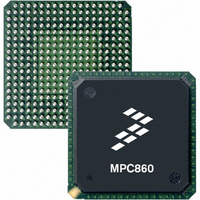MC68EN360ZQ25VL Freescale Semiconductor, MC68EN360ZQ25VL Datasheet - Page 262

MC68EN360ZQ25VL
Manufacturer Part Number
MC68EN360ZQ25VL
Description
IC MPU QUICC 32BIT 357-PBGA
Manufacturer
Freescale Semiconductor
Datasheets
1.MC68EN302AG20BT.pdf
(8 pages)
2.MC68EN360VR25L.pdf
(14 pages)
3.MC68EN360VR25L.pdf
(2 pages)
4.MC68EN360ZQ25VL.pdf
(962 pages)
Specifications of MC68EN360ZQ25VL
Processor Type
M683xx 32-Bit
Speed
25MHz
Voltage
3.3V
Mounting Type
Surface Mount
Package / Case
357-PBGA
Family Name
M68xxx
Device Core
ColdFire
Device Core Size
32b
Frequency (max)
25MHz
Instruction Set Architecture
RISC
Supply Voltage 1 (typ)
3V
Operating Supply Voltage (max)
3.3V
Operating Supply Voltage (min)
2.7V
Operating Temp Range
0C to 70C
Operating Temperature Classification
Commercial
Mounting
Surface Mount
Pin Count
357
Package Type
BGA
Lead Free Status / RoHS Status
Contains lead / RoHS non-compliant
Features
-
Lead Free Status / Rohs Status
Not Compliant
Available stocks
Company
Part Number
Manufacturer
Quantity
Price
Company:
Part Number:
MC68EN360ZQ25VL
Manufacturer:
Freescale Semiconductor
Quantity:
10 000
- MC68EN302AG20BT PDF datasheet
- MC68EN360VR25L PDF datasheet #2
- MC68EN360VR25L PDF datasheet #3
- MC68EN360ZQ25VL PDF datasheet #4
- Current page: 262 of 962
- Download datasheet (4Mb)
System Integration Module (SIM60)
The SyncCLK must always be at least 2 the desired serial clock rate, and at least 2.5 the
desired serial clock rate if the time slot assigner (TSA) in the SI is used. See 7.8 Serial Inter-
face with Time Slot Assigner for more information on how to select an appropriate frequency
for the SyncCLK.
6.5.5.5 SIMCLK. SIMCLK is supplied to the SIM60 module. SIMCLK defaults to VCO/2 = 25
MHz (assuming a 25-MHz system frequency). The SIMCLK is the same as the general sys-
tem clock when slow-go mode is programmed in the CDVCR, but can operate differently
from the general system clock when the LPSTOP instruction is executed. The SIMCLK is
controlled in the PLLCR.
During the LPSTOP instruction, the PLL can be left enabled or can be disabled to conserve
power. This option is determined by the STSIM bit in PLLCR. If the PLL is disabled, the SIM-
CLK is either the EXTAL/2 or the EXTAL/128/2 frequency, depending on the divide-by-128
option.
6.5.5.6 CLKO1. CLKO1 is the same as the general system clock frequency. CLKO1
defaults to VCO/2 = 25 MHz (assuming a 25-MHz system frequency). CLKO1 can drive full
strength, 2/3 strength, 1/3 strength, or be disabled. This option is controlled in the CLKOCR.
Disabling or decreasing the strength of CLKO1 can reduce power consumption, noise, and
electromagnetic interference on the printed circuit board.
During the LPSTOP instruction, the PLL can be left enabled or can be disabled to conserve
power. This option is determined by the STSIM bit in PLLCR. If the PLL is disabled, CLKO1
is either the EXTAL/2 or EXTAL/128/2 frequency, depending on the divide-by-128 option.
6.5.5.7 CLKO2. CLKO2 is 2 general system clock frequency in normal operation. The
CLKO2 VCO normally equals 50 MHz (assuming a 25-MHz system frequency). CLKO2 can
drive full strength, 2/3 strength, 1/3 strength, or be disabled. This option is controlled in the
CLKOCR. Disabling or decreasing the strength of CLKO2 can reduce power consumption,
noise, and electromagnetic interference on the printed circuit board.
6-18
Since SyncCLK does not clock very much logic on the QUICC,
SyncCLK is normally left at its full frequency (25 MHz). However,
to temporarily lower the value of SyncCLK during an application
to save more power, SyncCLK must remain at its highest fre-
quency (e.g., 25 MHz) until the general system clock is reduced.
Only then can SyncCLK be lowered, and it must never be low-
ered to a frequency less than the general system clock frequen-
cy.
The SIMCLK is always the same frequency as CLKO1.
CLKO1 is always the same frequency as the SIMCLK.
Freescale Semiconductor, Inc.
For More Information On This Product,
MC68360 USER’S MANUAL
Go to: www.freescale.com
NOTE
NOTE
NOTE
Related parts for MC68EN360ZQ25VL
Image
Part Number
Description
Manufacturer
Datasheet
Request
R
Part Number:
Description:
Manufacturer:
Freescale Semiconductor, Inc
Datasheet:
Part Number:
Description:
Manufacturer:
Freescale Semiconductor, Inc
Datasheet:
Part Number:
Description:
Manufacturer:
Freescale Semiconductor, Inc
Datasheet:
Part Number:
Description:
Manufacturer:
Freescale Semiconductor, Inc
Datasheet:
Part Number:
Description:
Manufacturer:
Freescale Semiconductor, Inc
Datasheet:
Part Number:
Description:
Manufacturer:
Freescale Semiconductor, Inc
Datasheet:
Part Number:
Description:
Manufacturer:
Freescale Semiconductor, Inc
Datasheet:
Part Number:
Description:
Manufacturer:
Freescale Semiconductor, Inc
Datasheet:
Part Number:
Description:
Manufacturer:
Freescale Semiconductor, Inc
Datasheet:
Part Number:
Description:
Manufacturer:
Freescale Semiconductor, Inc
Datasheet:
Part Number:
Description:
Manufacturer:
Freescale Semiconductor, Inc
Datasheet:
Part Number:
Description:
Manufacturer:
Freescale Semiconductor, Inc
Datasheet:
Part Number:
Description:
Manufacturer:
Freescale Semiconductor, Inc
Datasheet:
Part Number:
Description:
Manufacturer:
Freescale Semiconductor, Inc
Datasheet:
Part Number:
Description:
Manufacturer:
Freescale Semiconductor, Inc
Datasheet:











